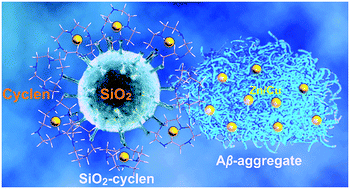Inhibition of metal-induced amyloid β-peptide aggregation by a blood–brain barrier permeable silica–cyclen nanochelator
Abstract
Alzheimer's disease (AD) is a neurodegenerative malady associated with amyloid β-peptide (Aβ) aggregation in the brain. Metal ions play important roles in Aβ aggregation and neurotoxicity. Metal chelators are potential therapeutic agents for AD because they could sequester metal ions from the Aβ aggregates and reverse the aggregation. The blood–brain barrier (BBB) is a major obstacle for drug delivery to AD patients. Herein, a nanoscale silica–cyclen composite combining cyclen as the metal chelator and silica nanoparticles as a carrier was reported. Silica–cyclen was characterized by scanning electron microscopy (SEM), transmission electron microscopy (TEM), Fourier transform infrared (FT-IR) and dynamic light scattering (DLS). The inhibitory effect of the silica–cyclen nanochelator on Zn2+- or Cu2+-induced Aβ aggregation was investigated by using a BCA protein assay and TEM. Similar to cyclen, silica–cyclen can effectively inhibit the Aβ aggregation and reduce the generation of reactive oxygen species induced by the Cu–Aβ40 complex, thereby lessening the metal-induced Aβ toxicity against PC12 cells. In vivo studies indicate that the silica–cyclen nanochelator can cross the BBB, which may provide inspiration for the construction of novel Aβ inhibitors.

- This article is part of the themed collection: Editors' Collection: Metals in Medicine


 Please wait while we load your content...
Please wait while we load your content...